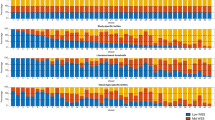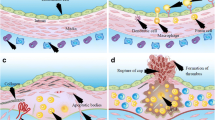Abstract
Wall stress (WS) is associated with high arterial pressure and affects the localization of atherosclerotic lesions. We sought to non-invasively investigate the distribution of WS along the length of human coronary arteries and investigate its potential effect on atherosclerosis in association with vascular stiffness, local arterial curvature and plaque volume. We reconstructed three-dimensionally 28 coronary arteries from 22 subjects who had undergone coronary computed tomography angiography. Coronary arteries were divided in 2 mm-long segments. WS, vascular stiffness, plaque volume and curvature were calculated in each segment using computational fluid dynamics and morphology measurements. Plaque segments exhibited lower WS compared to their adjacent normal segments. Within plaques, WS was lower in the mid plaque portion compared to the upstream portion. Plaque volume was higher in the mid plaque portion compared to upstream and downstream portions. Low WS was associated with high curvature and both low WS and high curvature were associated with increased plaque volume. The current study demonstrates that WS and plaque volume are not uniform in the longitudinal axis of human coronary plaque. Calculation of WS could serve as a surrogate for the localization of plaque development and the identification of plaques at a more advanced stage of progression.


Similar content being viewed by others
References
Heo KS, Fujiwara K, Abe J (2014) Shear stress and atherosclerosis. Mol Cells 37:435–440
Katranas SA, Kelekis AL, Antoniadis AP, Chatzizisis YS, Giannoglou GD (2014) Association of remodeling with endothelial shear stress, plaque elasticity, and volume in coronary arteries: a pilot coronary computed tomography angiography study. Angiology 65:413–419
Antoniadis AP, Papafaklis MI, Takahashi S, Feldman CL, Stone PH (2012) Role of endothelial shear stress in the destabilization of coronary plaque acute coronary syndromes and rapid plaque progression. In: Arampatzis C, McFadden EP, Michalis LK, Virmani R, Serruys PW (eds) Coronary atherosclerosis: current management and treatment. Informa Healthcare, London, pp 212–226
Zhu H, Friedman MH (2003) Relationship between the dynamic geometry and wall thickness of a human coronary artery. Arterioscler Thromb Vasc Biol 23:2260–2265
Katranas SA, Kelekis AL, Antoniadis AP, Giannoglou GD (2013) The cardiac cycle effects on the coronary arterial geometry and hemodynamics: an in vivo CT angiography study. Int J Cardiol 168:2935–2936
Schaar JA, de Korte CL, Mastik F, Baldewsing R, Regar E, de Feyter P, Slager CJ, van der Steen AF, Serruys PW (2003) Intravascular palpography for high-risk vulnerable plaque assessment. Herz 28:488–495
Thubrikar MJ, Robicsek F (1995) Pressure-induced arterial wall stress and atherosclerosis. Ann Thorac Surg 59:1594–1603
Glagov S, Zarins CK, Giddens DP, Ku DN (1989) Mechanical factors in the pathogenesis, localization and evolution of atherosclerotic plaques. Springer, Berlin
Coskun AU, Yeghiazarians Y, Kinlay S, Clark ME, Ilegbusi OJ, Wahle A, Sonka M, Popma JJ, Kuntz RE, Feldman CL, Stone PH (2003) Reproducibility of coronary lumen, plaque, and vessel wall reconstruction and of endothelial shear stress measurements in vivo in humans. Catheter Cardiovasc Interv 60:67–78
Kelly RF, Snow HM (2011) The effect of arterial wall shear stress on the incremental elasticity of a conduit artery. Acta Physiol 202:1–9
Antoniadis AP, Chatzizisis YS, Giannoglou GD (2008) Pathogenetic mechanisms of coronary ectasia. Int J Cardiol 130:335–343
Malek AM, Alper SL, Izumo S (1999) Hemodynamic shear stress and its role in atherosclerosis. JAMA 282:2035–2042
Cohn JN, Duprez DA, Grandits GA (2005) Arterial elasticity as part of a comprehensive assessment of cardiovascular risk and drug treatment. Hypertension 46:217–220
Zieman SJ, Melenovsky V, Kass DA (2005) Mechanisms, pathophysiology, and therapy of arterial stiffness. Arterioscler Thromb Vasc Biol 25:932–943
Ross R (1999) Atherosclerosis–an inflammatory disease. N Engl J Med 340:115–126
Mitchell GF, Pfeffer MA (1999) Pulsatile hemodynamics in hypertension. Curr Opin Cardiol 14:361–369
Author information
Authors and Affiliations
Corresponding author
Ethics declarations
Conflicts of interest
None.
Rights and permissions
About this article
Cite this article
Katranas, S.A., Antoniadis, A.P., Kelekis, A.L. et al. Insights on atherosclerosis by non-invasive assessment of wall stress and arterial morphology along the length of human coronary plaques. Int J Cardiovasc Imaging 31, 1627–1633 (2015). https://doi.org/10.1007/s10554-015-0736-5
Received:
Accepted:
Published:
Issue Date:
DOI: https://doi.org/10.1007/s10554-015-0736-5




